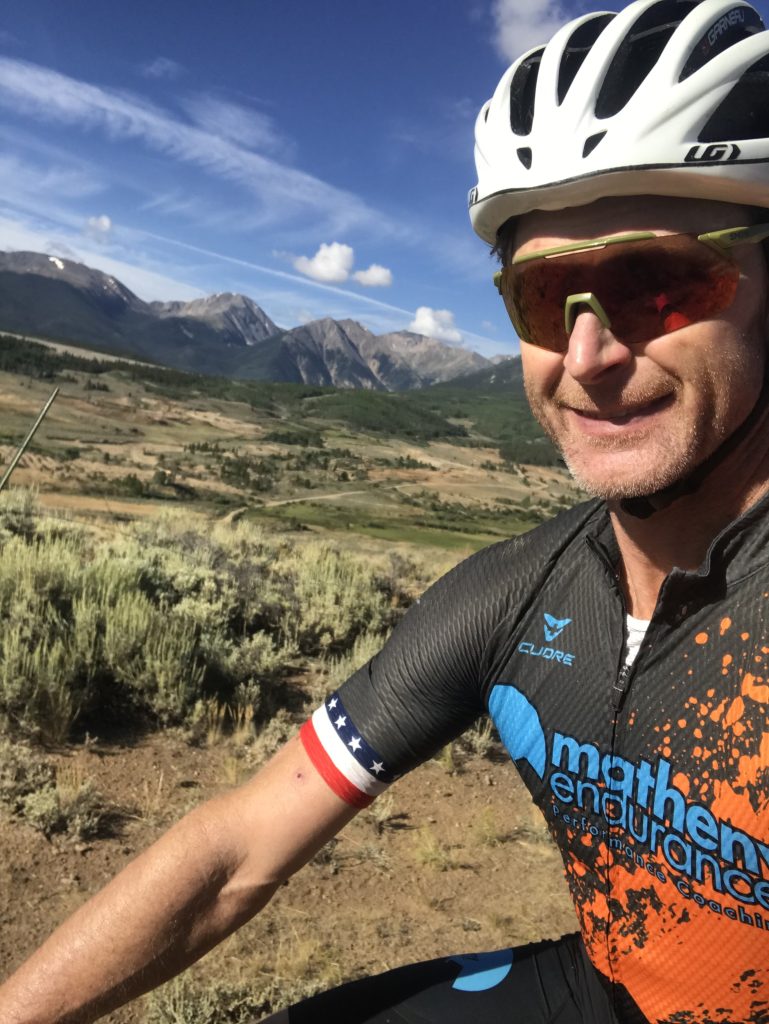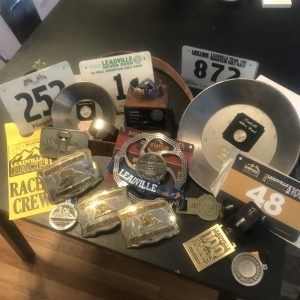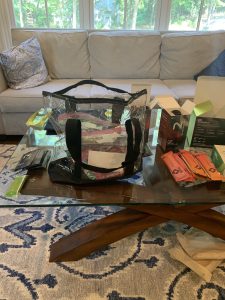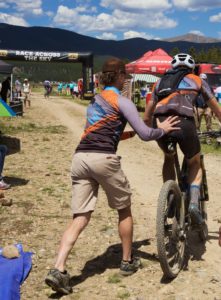
Faking a smile through the Grit!
Why attempt a self-supported solo time trial effort of the Leadville 100 mountain bike course?
That’s a good question. I asked myself this but not as thoroughly as most may think. Simply stated, I’m kind of a sicko in that Type 2 fun kinda way, but the answer isn’t so cut and dry. If this suites your fancy; as Doc Holiday says, “I’m your Huckleberry! Say when.” and read on.
 Reflecting, I have a running history with Leadville spanning back to 2007 when I first supported a friend and mentor when I was a Junior. Steve Wilson was the owner of the bike shop and had traveled from Kentucky to tackle the event but was unfortunately taken out with a dislocated shoulder at the base of Powerline. And not how you think by his own demise but by a spectator’s purse as she jumped across course. Eventually, I toed the line, this is where I date myself, racing it on 26” wheels completing it in a respectable time of 8:19 even with a flat tire and a broken derailleur cable. I knew I had more so I returned the next year for a clean run knocking nearly an hour off my time clocking 7:23.
Reflecting, I have a running history with Leadville spanning back to 2007 when I first supported a friend and mentor when I was a Junior. Steve Wilson was the owner of the bike shop and had traveled from Kentucky to tackle the event but was unfortunately taken out with a dislocated shoulder at the base of Powerline. And not how you think by his own demise but by a spectator’s purse as she jumped across course. Eventually, I toed the line, this is where I date myself, racing it on 26” wheels completing it in a respectable time of 8:19 even with a flat tire and a broken derailleur cable. I knew I had more so I returned the next year for a clean run knocking nearly an hour off my time clocking 7:23.
I’ve ridden the course more times than I’d like to admit as a mountain bike coach leading camps for the organization (when it was locally owned & after changing hands to Lifetime), when CTS was the coaching sponsor, as well as private camps for my coaching clients. I’ve spent full days in the pits crewing for athletes where I’ve left feeling more wrecked than the days I’d raced it. I’ve got an entire Excel workbook dedicated with tabs of nutrition plans, pace charts, watt/kgs, for over a decade’s worth of data that helps me educate athletes for their big dance to obtain that buckle!

Hardware from the hard work.
Even with that continuous experience, I felt I was losing touch with the personal association. I attribute this to the combination of the race evolving to its current state and my race times being long enough ago that I didn’t even record the data points for myself. I felt the desire to reconnect with the pace and effort relative to what I’m coaching athletes on in the day-to-day and be better informed of data for a race effort.
That segues us right into the deeper whys.
Gain 1st-hand experience
I’ve always loved the process and understanding the “Why?” behind most things. That’s probably one of the underlying reasons I became a Pro and a coach simultaneously. I could apply the concepts I was learning while pursuing my degree in Exercise Science and Nutrition directly to what I was experiencing first-hand simultaneous to pursuing performance. It must have worked as I graduated and obtained my Pro MTB license in the same year!
I’ve heard some coaches and sports scientists say “You don’t have to be an accomplished athlete to be a proficient coach”, but my personal experience from the trenches sure does speak to understanding the athletes’ experience. Being able to speak to this level of understanding develops a deeper level of trust & relationship with athletes in their journeys.
Conversely, I’d say it can be more challenging for an accomplished athlete without any formal physiology or coaching education to be a proficient coach because the prescription can often become “what worked for me…” I state this because this experiment could be seen as just that, “what worked for me”, but I executed a plan based on coaching principles. The outcome possibly wasn’t the way I would have raced it, to be honest.
To Prove a point
Yep! That’s me I’m kinda stubborn and prideful at times. Sometimes that trait can be a downside, but also what gets results through persistance. I often get the impression that some think results come easy to me. I’ve never been handed results. Honestly, I’ve been an underdog in the sport clawing my way out of small-town Kentucky where there frankly isn’t a cycling culture. I’ve earned results from continuously showing up, doing the work, and going to the well day after day.
But what point did I prove? That although the event deserves respect; it isn’t as all-consuming as most believe. Athletes go bananas with everything surrounding this event! I frankly wanted to put it into perspective that you can complete it with a less-than-perfect scenario. Don’t get me wrong, it is a big undertaking, but given you’ve done your work and like Ken says, “you can do more than you think you can! Dig deep!”
To Complete the new course & gather data

The course has changed over the years and more dramatically recently. To note these changes surmount;
- removal of the original “wall” and building proper single track at approximately mile 35 outbound
- removal of two-way traffic on the single track with at approximately mile 33-36 outbound and 68-71 inbound
- This reroute removes “the Bitch” or “Cramp Hill” inbound as well now. You know this quick loose rocky plunge at mile 33 out but it’s no more inbound.
- A detour around private property at the base of the Columbine climb before Lost Canyon Rd at approximately mile 44 outbound and mile 60 inbound.
- Relocating the summit of Columbine to avoid the quick traverse, descent, and climb back up at the turn-around point ~52mi
With all these changes, it was due time for a personal run!
Each athlete has different capabilities and capacities, not to mention a differing psyche so taking to the course to test “racing” versus “pacing”. For me, it’s extremely difficult to “pace” an effort if I were part of the actual race. I’m often much better at “racing the race” than what my data and pacing suggest. In fact, in my opinion, that’s inherently why one should sign up for a race in the 1st place is…. to well…race the race!
To Test fueling

Bags upon bag of sugar!
The carbohydrate revolution is all the craze in endurance sports. This isn’t too shocking as I’ve always been mentored that “carbs are king” and even that “fats burn in a carbohydrate flame.” But I haven’t trusted everything at face value and have done self-testing from periods of low and high to different combinations of all sports mix, all water and sports nutrition, all whole foods, a mix, and in-between. I believe there are different ideal approaches for different athletes in different situations. The bottom line is context matters down to what you’ve adapted to, conditions, durations, intensities, palates, and importantly absolute output. We’re not World Tour pros and following their regimes can be problematic. So be careful reading what the media feeds you and following it blindly. I’ve had people get sick and upset months of training just trying to mimic the media’s report. So just as I ask my athletes to test and understand; what better way than to add another data point with a personal perspective to help athletes in their endeavors?
For the ride & test my limits
I still love a challenge, an occasional race, and simply going for a ride. Am I a little crazy? You betcha! But there’s no way I could race the race while effectively supporting my athletes. On race day my focus was 100% on the athletes I coach.

It’s like the airline attendants’ spiel, “In the case of loss of oxygen; masks will drop from above. Please secure your mask before assisting others.” The same goes in life, if you don’t take care of yourself, then you’re not present to help others. In this case, if I’m going to be all hands on deck helping sort, simplify, and gather aid bags, wake at the crack of dawn assisting athletes before the start, jetting out to aid stations to set up full-service support, and being there for the entire day; then I want to have myself behind me. I didn’t want to detract from their experience. And both of us know deep down that I 100% empathize with what they are enduring!
Couldn’t I have just signed up and done the race you ask?
Sure! Unfortunately or fortunately, I’ve had a long enough experience with the event that I’ve seen it pre-Lifetime. Which creates mixed feelings about the Leadville race and frankly Lifetime. There are positives and negatives to that, that I won’t go into here. But the challenge is the utmost cost and monopoly it has created towards Lifetime branded events with the qualifier and corral system. It’s really difficult (and not to mention expensive) to get into the event. I could attend a qualifier and have done so in the past as the previous overall winner of Silver Rush & podium finisher at Austin Rattler, but that’s another expense and subsequent travel to said qualifier. I’m not about repeatedly attending the same events, but seeking new events for the experience.
If you got lost, the reasons behind my bright idea to make a solo run at the 105.5 miles!
- Refresh 1st-hand experience
- Gather complete data on the new course
- Test fueling
- Test pacing versus racing
- Selfish completion
- Embrace the ride
Now let’s see how this goes and if I checked off the list. Read on in Part 2 Blow by Blow Course preview and Part 3 Power Analysis for how it unfolded and the full data-exposing outcome.
If you want more information about coaching, consulting, or how I can uniquely assist reach out.
If you found it valuable then please consider scheduling a consultation or donating Venmo @mathenyd or Paypal @Matheny